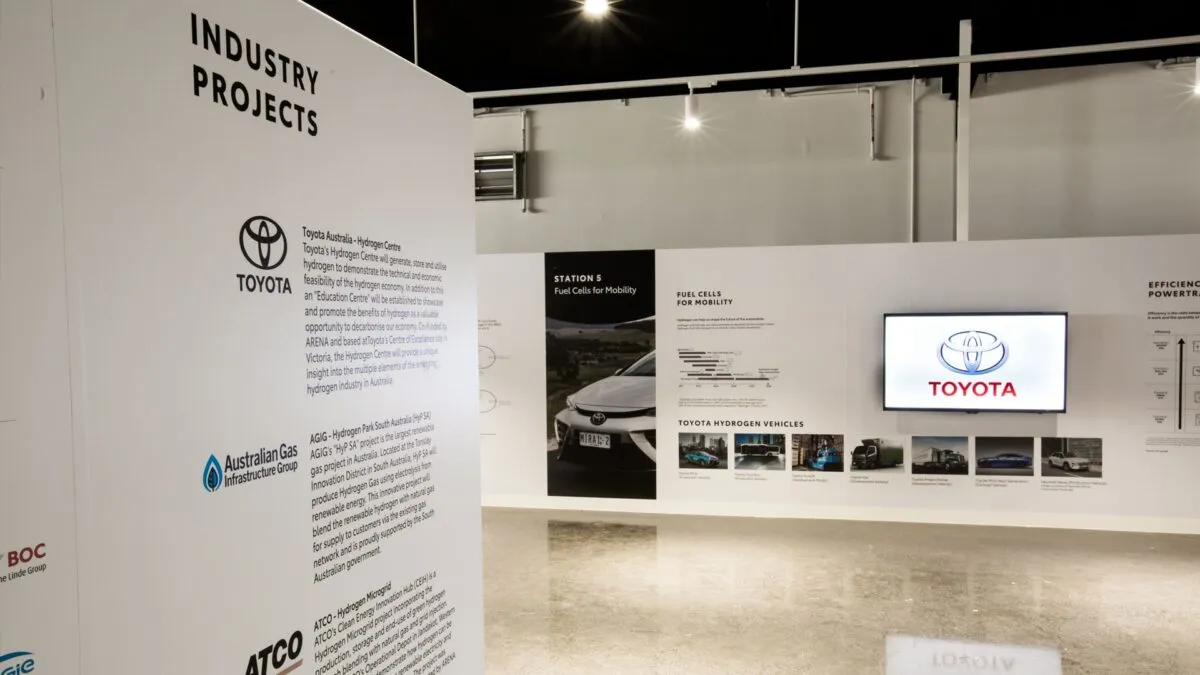Toyota Celebrates Earth Day and Reiterates Importance of Taking Care of Our Planet
April 22, 2020
Categories:

Toyota’s education facility at the new Hydrogen Centre demonstrates how hydrogen can play a significant role in the future of transport and the broader energy economy.
Toyota Australia has marked the 50th anniversary of Earth Day with the unveiling of the first stage of its Hydrogen Centre at the Toyota Centre of Excellence in Altona, Melbourne.
This first stage of the $7.4 million Hydrogen Centre – developed with $3.1m of funding support from the Australian Renewable Energy Agency (ARENA) – comprises an education facility designed to demonstrate how hydrogen can play a significant role in both the future of transport and the broader energy economy.
While the current COVID-19 restrictions mean the education centre is unable to welcome visitors at present, its completion marks an important step in Toyota’s ongoing action to address climate change and its continued sustainable development.
Earth Day – recognised on April 22 every year – was established in 1970 and is now the world’s largest environmental movement with over 75,000 partners in more than 190 countries helping to drive action to combat environmental degradation.
This year, the theme for action is climate change, an area that Toyota has been focussed on and is investing in heavily in line with the global Toyota Environment Challenge 2050 announced in 2015. The global Toyota Environment Challenge aims to reduce global average CO2 emissions from its new vehicles and manufacturing plants and facilities by 35 per cent by 2030 compared to 2013 levels.
Hydrogen future leads the way on climate action
Toyota Australia Manager Future Technologies and Mobility Matt MacLeod said locally, the company’s investment in the hydrogen economy, the increased availability and demand for its hybrid vehicles, and its growing solar capacity at its Australian facilities are providing a significant contribution to meeting the global CO2 reduction targets.
“Targeting CO2 emissions is a major goal of the global Toyota Environment Challenge 2050 and for the longer term, we are committed to developing and promoting hydrogen as a viable fuel for zero-emission transport as well as playing a larger role in the broader energy economy,” Mr MacLeod said.
“The education facility at the Hydrogen Centre is about informing and demonstrating the opportunity to meet the energy needs of our society in the not too distant future. To help cater for that, the centre will also incorporate a permanent sustainable hydrogen production and storage facility alongside a commercial grade refueling station that is due to be completed by the end of the year.
“Currently, cars and light commercial vehicles contribute about 11 per cent of Australia’s transport CO2 emissions. The Toyota Mirai FCEV (Fuel Cell Electric Vehicle) that has been trialed for the past year by a number of organisations including local councils in Melbourne produces zero harmful emissions – nothing but water vapour,” he said.
More hybrid vehicles mean lower CO2 emissions now
While Toyota is committed to developing hydrogen FCEVs, in the immediate term, the demand and growing availability of hybrid petrol electric vehicles is helping to reduce CO2 emissions from the more than 130,000 it has delivered to Australian drivers since 2001.
Hybrid powertrains are now offered in Prius, Prius V, Corolla Hatch, Corolla Sedan, Camry, C-HR and RAV4 models, and for the first three months of this year, accounted for 23.5 per cent of all Toyota sales – more than the total of hybrid models sold in 2018.
With the all new Yaris Hybrid due to arrive later this year, it will further expand the range and offer the lowest fuel consumption – and therefore CO2 emissions – of any Toyota vehicle in Australia with an official combined figure of just 3.3l/100km1 and CO2 emissions of 76g/km2.
Solar energy key to reducing emissions from facilities
Toyota is also actively pursuing means of reducing emissions from its facilities in Australia through installing renewable energy capacity and over the past two years has expanded its solar capacity to 1156kW across three key properties in Sydney, Altona and Brisbane.
This solar capability has contributed to a reduction in CO2 emissions of 8,835 tonnes. An additional 87kW solar system will soon be commissioned at the Altona site linked to the Hydrogen Centre redevelopment.
The largest of these solar systems is for the 6.4 hectare Toyota Parts Centre in western Sydney that is covered with a 605kW solar array made up of 2,200 panels. The system is capable of generating 874MWh per annum which will help deliver on the target for it to be a zero CO2 emission facility by the end of this year.
CO2 sequestration through support for National Tree Day
For Toyota, reducing emissions is only part of the solution and for the past 20 years, it has been a major partner to Planet Ark for its annual National Tree Day and Schools Tree Day programs which have seen more than 25 million trees planted around the country.
Revegetating the land has numerous benefits including reducing soil erosion, lowering local ambient temperatures and improving habitats for wildlife and birds and a large healthy tree can also sequester up to 93kg of CO2 per year3.
Toyota’s commitment to reducing its carbon emissions remains a high priority and on this Earth Day, it is proud to acknowledge the achievements the movement has made over the past 50 years in helping to provide a better environment for all for the future.
For more information on Earth Day visit earthday.org.
For more information on the Toyota Environmental Challenge 2050, visit here.



























